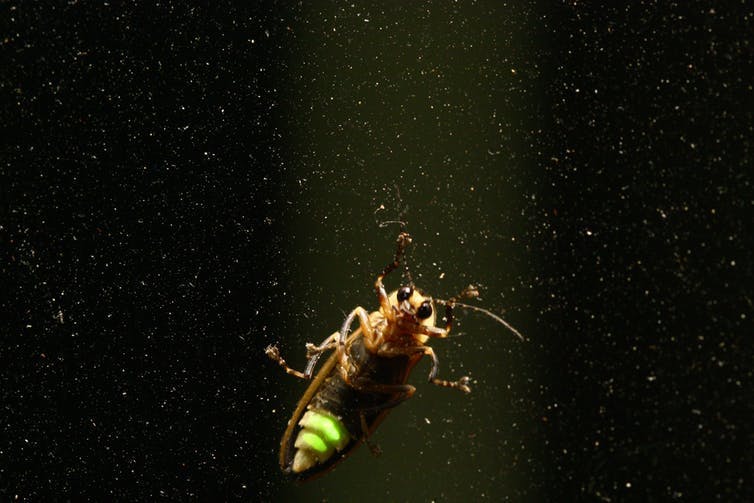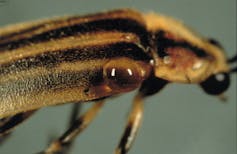
Why some fireflies become femme fatales in their race for survival
by Prayan Pokharel, University of Giessen
Fireflies are the flashy stars of the insect world. At night, you can see them coming because each little bug shines like a lamp – and, appropriately, they belong to the beetle family Lampyridae.
The “lamplight” of fireflies is generated by an enzyme inside the bugs’ abdomens called luciferase, which reacts with other elements and compounds to produce a cold light. This turns each individual firefly into a bioluminescent beauty.
Their glow is also used for courtship. Males of different firefly species use different flash patterns to attract potential mates. A male firefly will flash in a certain pattern for a particular length of time; he knows whether the female he’s spotted is interested based on how long it takes her to “flash” in reply.
This all sounds very romantic and beautiful. But there’s a dark secret lurking behind the facade: some female fireflies dupe the males with false flash patterns – then, when their amorous would-be partners approach, they attack and eat them. The femme fatales aren’t doing this from malice or hunger: they’re trying to ingest a toxin that will keep them safe from predators.
“Come closer…”
This lethal mating ritual happens in two genera of fireflies, Photinus and Photuris. Both of the fireflies are native to North America.
The Photuris female is able to mimic Photinus’ flashing patterns; with this deception, she answers the flash patterns of a Photinus male. He comes closer, hoping to consummate their new relationship. Instead, she captures and eats him.
Why? Because, as the saying goes, “You are what you eat.” In this case, the Photuris female eats the Photinus male to get chemical defenses that are present in his blood. The toxins can be used to fight off predators like birds, spiders, ants and others.
When the Photinus male is under attack, the toxins are released as tiny droplets. By eating the male, the Photuris female absorbs that toxic power and makes herself safer from predation. The powerful toxins are called lucibufagins, which are steroids similar to the heart poison generated from the foxglove plant, Digitalis.
When a firefly is attacked its outer skin, called the cuticle, ruptures and bitter tasting blood loaded with lucibufagins oozes out. Predators release the firefly because they can’t stand the taste.

Avoidance tactics
When a female Photuris eats a Photinus male and absorbs his lucibufagins, she is also protecting her young. The females are able to pass on this toxic defence mechanism to their offspring.
The Photinus males try to protect themselves from being eaten by Photuris females. They take their time looking for the real thing: a female of their own species. One study, in a laboratory showed that Photinus males took more than seven nights to find a female of its own species, while a Photinus female of the same species took less than six minutes to attract a male for mating.
The Photinus males also change their light emitting patterns in a bid to mislead their nemesis or – if they’re quick enough – simply fly away as soon as they are realize they’ve been drawn into a trap.
Prayan Pokharel is a doctoral student at the Institute for Insect Biotechnology, University of Giessen
This article was originally published on The Conversation. Read the original article.












